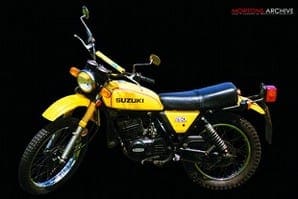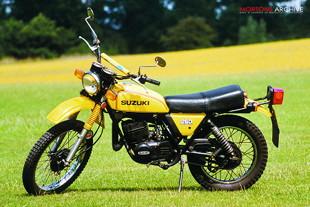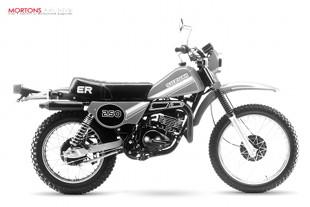
In 1968 Yamaha launched their ground breaking DT-1. A Japanese company had finally invested in developing a reliable, well mannered and economical off-road machine. Until that point the only competition had mostly been big and heavy British bikes. The only alternatives came from Greeves, Montesa and Husqvarna, but they were all hideously expensive. The DT1 was a winner out of the blocks and it was only a matter of time before another Japanese factory released something to compete with it.
Suzuki presumably acquired a few Yams and investigated what made them tick because their take on the theme went on to be equally successful if not more so.
 It’s sometimes said that first to market does all the hard work while second to market picks up a lot of the profits and it’s doubtful Suzuki’s bean counters could ever have complained about the return of profits they received from Yamaha’s initial flash of inspiration.
It’s sometimes said that first to market does all the hard work while second to market picks up a lot of the profits and it’s doubtful Suzuki’s bean counters could ever have complained about the return of profits they received from Yamaha’s initial flash of inspiration.
The styling of a motorcycle is very much a personal thing but only the most churlish of Japanese enthusiasts would suggest the early TS250s are anything other than inspired.
Although overtly dirt bikes, the aesthetics were carefully orchestrated to mirror the company’s road going machinery. Quite possibly it’s not fair to highlight specific models within the range but the 1970-1974 examples are some of the best eye candy to ever leave Japan.
Later machines undoubtedly have a more off-road look about them and there’s an intimation of the company’s successful PE series. The handling may not have been quite as refined as the contemporary Yamahas but there’s little to choose between them in day-to-day use. Some may argue the TS250 was a bit more agricultural but this facet of its character meant it wasn’t likely to grenade if given abuse. In point of fact the TS250 motor was used in fair numbers by the Vic Camp race school in the 1970s. If the motor can take this level of ill treatment it speaks volumes of its design and build qualities.
 It would have been easy for Suzuki to have rested on their laurels and just taken the cash but to their credit the bike was consistently upgraded year-on-year to keep it abreast of fashion and the competition. By Japanese standards the 12-year model run was a fitting tribute to the original design. Many were used as hacks and later became field bikes. It’d be heresy to use one for that now.
It would have been easy for Suzuki to have rested on their laurels and just taken the cash but to their credit the bike was consistently upgraded year-on-year to keep it abreast of fashion and the competition. By Japanese standards the 12-year model run was a fitting tribute to the original design. Many were used as hacks and later became field bikes. It’d be heresy to use one for that now.
Timeline: 1969 TS250
The first and probably rarest. Silver side panel on LHS, banana exhaust on RHS with a four fluted chrome heat guard. Chrome guards front and rear; mid-green tank sports period golden wings emblem and Suzuki Gothic ‘S’ logo
1970 TS250II
Same 18.5bhp motor. Tank now Chrome orange or Pholina Yellow with same winged S but Suzuki name also added on black decal. The rear mudguard, rear light, speedo and tachometer, exhaust and heat shield are all subtly modified. Seat cover uses diamond shaped stitching.
 1971 TS250R
1971 TS250R
Motor’s power raised to 22/23bhp, previous points ignition replaced by PEI pointless ignition system. Wheelbase extended, chrome guards replaced with painted units matching tank, which runs a broad white decal to lower third. Metal winged badge dropper. Rear shocks gain small chrome top shroud. Smooth seat cover.
1972 TS250J
Little change other than graphics, which use a broad three line decal to lower third of the tank with a forward facing right angled arrow flowing to the top of the tank. Colours: Strip Orange or Daytona Blue
1973 TS250K
Rear light changes for some markets. Chrome heat guard on silencer now a metal pressing with six elliptical holes and 250 emblem. Carb increase in size 28mm; VM28SH. Graphics change to orange band running across the tank near seat nose and end at front edge. Colours Pine Green, Sunset Orange and White.
1974 TS250L
Colour scheme and graphics change. Colours: Marble Red with blue and white graphics.
1975 TS250M
A very popular and common bike in the UK. Silver tank with dramatic blue slash-style decals
 1976 TS250A
1976 TS250A
Major styling revisions with white front mudguard contrasting against Laredo red tank. Silencer heat guard restyled with six rectangular holes. Engine painted satin black and wheels change from steel to aluminium. Last year of single down tube frame.
1977 TS250B
Double front tubes adopted. Reed valve replaces older piston ported engine design. Exhaust restyled, spark arrestor added and heat shield is 50/50 chrome and tank colour. Heavily angled gas/oil rear shocks fitted. Conical front hubs used. Other than makers name no decals to tank in solid red, yellow or green.
1978 TS250C
Revised graphics, single throttle cable, plastic rear guard painted to match tank; Pholina yellow, scarlet medium red or blue
1979 TS250ER N
Heavily revised panel work largely in plastic based around RM/PE series, side panels having racing number ovals, black seat with ER logo. Clocks square in profile, head lamp fitted with enduro type shroud that clips to forks, swing arm now box section Pholina yellow, egret white or marble pure red.
1980 TS250T, TS250X
Heavily revised panel work largely in plastic. Clocks now square in profile, headlamp fitted with enduro type shroud, swing arm now box section. Monoshock rather than twin-shock suspension. ![]()




